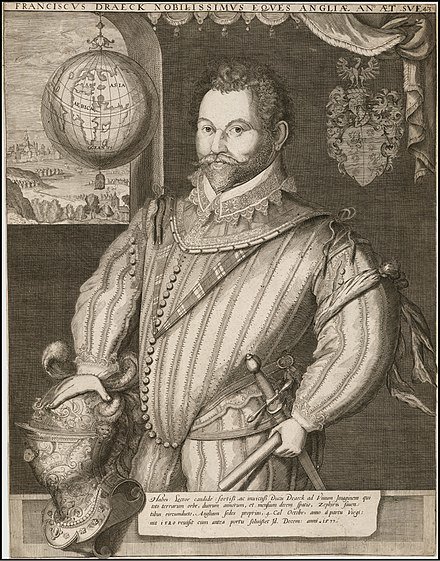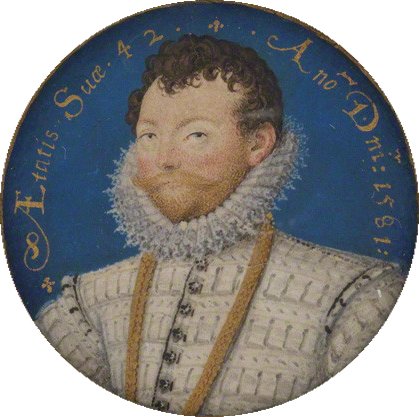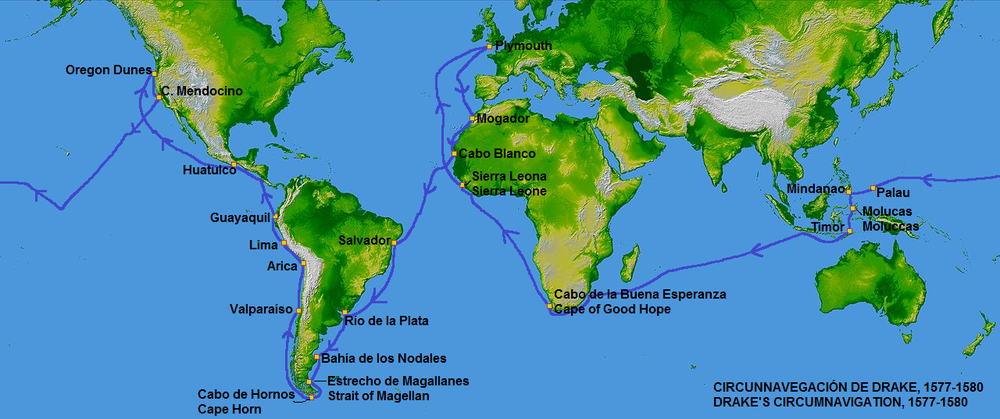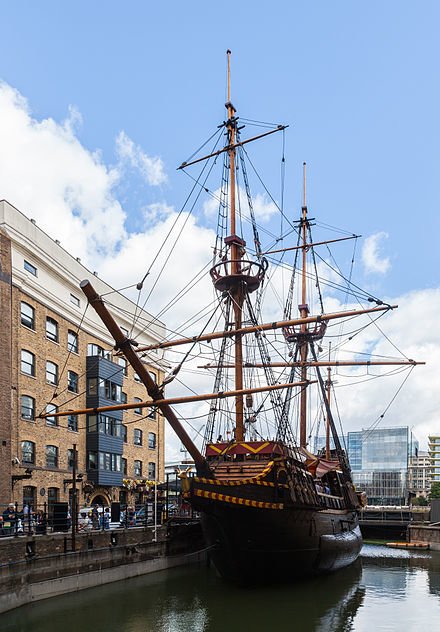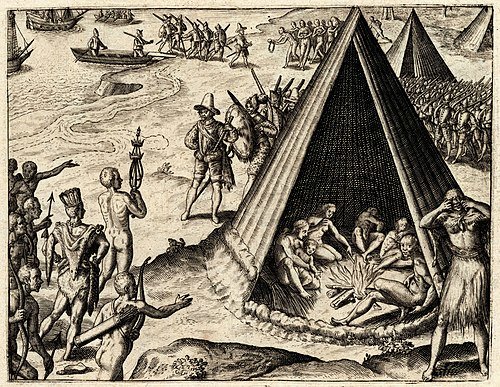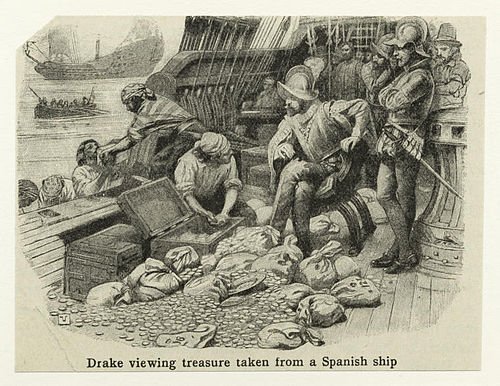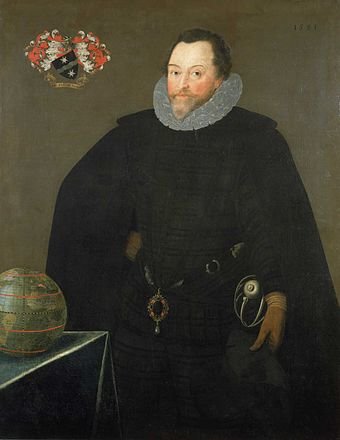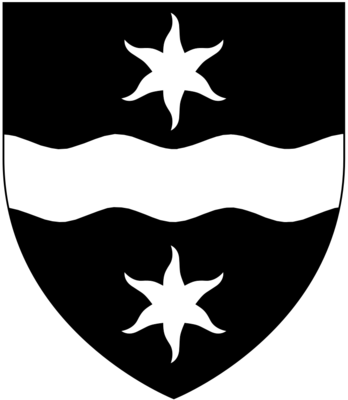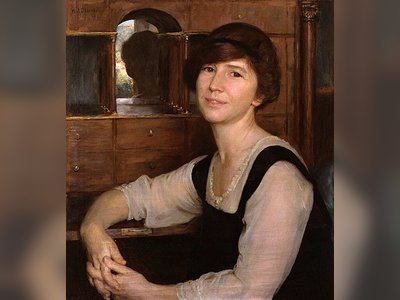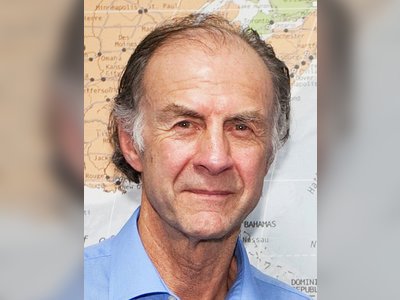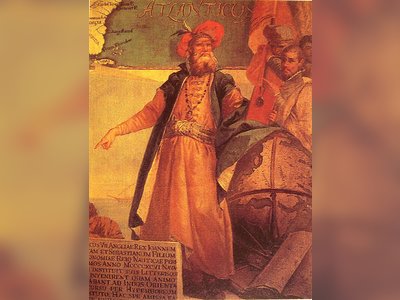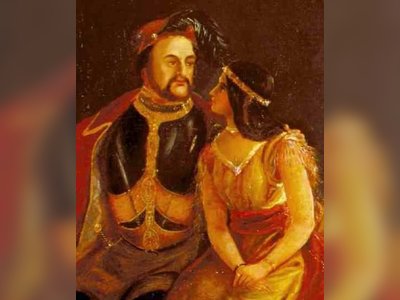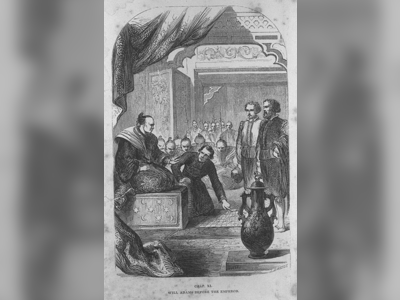Francis Drake - Pirate or Paragon?
***TOO LONG***Sir Francis Drake (1540–1596) was an English explorer, sea captain, privateer, slave trader, naval officer, and politician. Drake is best known for his circumnavigation of the world in a single expedition, from 1577 to 1580, including his incursion into the Pacific Ocean, and claiming for England what is now the state of California. His expedition inaugurated an era of conflict with the Spanish on the western coast of the Americas. In 1581 Elizabeth I awarded Drake a knighthood which he received on the Golden Hind in Deptford. He was vice admiral of the English fleet in the victorious battle against the Spanish Armada in 1588. Drake's exploits made him a hero to the English, but his privateering led the Spanish to brand him a pirate, known to them as El Draque. King Philip II of Spain allegedly offered a reward of 20,000 ducats for his capture or death, equivalent to around £6 million (US$8 million) in 2015.
Sir Francis Drake (c. 1540 – 28 January 1596) was an English explorer, sea captain, privateer, slave trader,naval officer, and politician. Drake is best known for his circumnavigation of the world in a single expedition, from 1577 to 1580. This included his incursion into the Pacific Ocean, until then an area of exclusive Spanish interest, and his claim to New Albion for England, an area in what is now the U.S. state of California. His expedition inaugurated an era of conflict with the Spanish on the western coast of the Americas, an area that had previously been largely unexplored by Western shipping.
Elizabeth I awarded Drake a knighthood in 1581 which he received on the Golden Hind in Deptford. In the same year he was appointed mayor of Plymouth. As a vice admiral, he was second-in-command of the English fleet in the victorious battle against the Spanish Armada in 1588. After unsuccessfully attacking San Juan, Puerto Rico, he died of dysentery in January 1596.
Drake's exploits made him a hero to the English, but his privateering led the Spanish to brand him a pirate, known to them as El Draque. King Philip II of Spain allegedly offered a reward of 20,000 ducats for his capture or death, equivalent to around £6 million (US$8 million) in 2015.
Francis Drake was born in Tavistock, Devon, England. Although his birth date is not formally recorded, it is known that he was born while the Six Articles were in force. His birth date is estimated from contemporary sources such as: "Drake was two and twenty when he obtained the command of the Judith" (1566). This would date his birth to 1544. A date of c. 1540 is suggested from two portraits: one a miniature painted by Nicholas Hilliard in 1581 when he was allegedly 42, so born circa 1539, while the other, painted in 1594 when he was said to be 52, would give a birth year of around 1541. Lady Elliott-Drake, the collateral descendant, and final holder of the Drake Baronetcy, argued in her book on 'The Family and Heirs of Sir Francis Drake' that Drake's birth year was 1541.
He was the oldest of the twelve sons of Edmund Drake (1518–1585), a Protestant farmer, and his wife Mary Mylwaye. The first son was alleged to have been named after his godfather Francis Russell, 2nd Earl of Bedford.
Because of religious persecution during the Prayer Book Rebellion in 1549, the Drake family fled from Devon to Kent. There Drake's father obtained an appointment to minister the men in the King's Navy. He was ordained deacon and was made vicar of Upnor Church on the Medway. Drake's father apprenticed him to his neighbour, the master of a barque used for coastal trade transporting merchandise to France. The ship's master was so satisfied with the young Drake's conduct that, being unmarried and childless at his death, he bequeathed the barque to Drake.
Marriage and family
Francis Drake married Mary Newman at St. Budeaux church, Plymouth, in July 1569. She died 12 years later, in 1581. In 1585, Drake married Elizabeth Sydenham—born circa 1562, the only child of Sir George Sydenham, of Combe Sydenham, who was the High Sheriff of Somerset. After Drake's death, the widow Elizabeth eventually married Sir William Courtenay of Powderham.
Early career at sea
Scholars think it is likely Francis Drake was illegitimate, and that is probably why he was placed at an early age into the household of William Hawkins of Plymouth. Drake began his seagoing training as an apprentice on Hawkins' boats. By 18, he was a bursar, and in the 1550s, Drake's father found the young man a position with the owner and master of a small barque, one of the small traders plying between the Medway River and the Dutch coast. Drake likely engaged in commerce along the coast of England, the Low Countries and France. On the death of the barque's owner, Drake was given the barque, though it is possible the small boat may already have belonged to one of the Hawkinses, for whom Drake was working it. Loades says: "Whatever the truth of the matter, Drake seems to have completed his training out of the Medway".
Anecdotal evidence indicates Francis next served in a fairly humble capacity, as a seaman, on a series of voyages on the ships of William's cousin, John Hawkins, between 1560 and 1568. As a humble sailor, Drake is seldom mentioned by name in any of the records. They carried mainly cloth and manufactured goods, often contraband, but piracy was also a lure. On a trip to Guinea, John Hawkins brought home to England valuable cargoes of gold, ivory, pepper, and an idea. The West African slave trade was officially a Portuguese monopoly, but John Hawkins devised a plan to break into that trade, and in 1562, enlisted the aid of friends and family to finance the venture. It was a success: Hawkins returned in 1563 a rich man.
Hawkins immediately began planning his next trip, gaining both Queen Elizabeth's support in the form of a ship, Jesus de Lubeck, and the rest of his needed venture capital from a consortium of investors. Drake was twenty (c. 1563–1564), and not a member of that consortium when he sailed on Hawkins' second voyage, but the crew would have received a share in the profits. Therefore, scholars such as Kris Lane list Drake with Hawkins as one of the first English slave traders.
That second run was also a success. However, the Spanish and Portuguese had become aware of what the English were doing, so they sent their London ambassadors to lodge complaints with Queen Elizabeth. Spain and Portugal were the major seafaring powers of the sixteenth century, holding established trade monopolies, including the west African slave trade. England was small, relatively poor, and struggling from civil and religious division. Elizabeth was not willing to risk war with Spain, so the Queen instructed Hawkins not to undertake a third trip that year. Hawkins agreed, then covertly furnished John Lovell with the fleet to do it for him. Drake's presence on earlier voyages has been mostly assumed, but there is firm testimony that Drake was on board one of Lovell's ships for this voyage.
In 1566–1567, sailing under Captain John Lovell on one of a fleet of ships owned by the Hawkins family, they attacked Portuguese settlements and slave ships on the coast of West Africa and then sailed to the Americas and sold the captured cargoes of enslaved Africans to Spanish plantations. The voyage was largely unsuccessful and more than 90 enslaved Africans were released without payment. When Lovell arrived back in Plymouth in 1567 with these disappointing results, Hawkins' "Third Troublesome Voyage" (fourth if Lovell's is included) was planned. It would be a turning point in Drake's life.
One account of "The Troublesome Third voyage" has Drake as Captain of Hawkins' ship Judith from the beginning of the voyage, whereas another account places him as a junior officer aboard the Jesus of Lubeck instead. Whitfield says, "The voyage began badly, and it grew progressively worse". The voyage ended in the ill-fated 1568 incident at San Juan de Ulúa.
Storms, Spanish hostility and African resistance, armed conflict, and finally a hurricane, separated one ship from the fleet to find its own way home, and damaged the others forcing them to find a port where they could make repairs. After arriving in San Juan de Ulua, the port of Vera Cruz, the newly appointed viceroy of New Spain arrived with a fleet of ships. While still negotiating to resupply and repair, Hawkins' ships were attacked by the fleet of Spanish warships, with all but two of the English ships lost. The Jesus de Lubeck was set on fire. Drake escaped, surviving the attack by swimming. The Judith departed leaving Hawkins and the Minion to limp along alone toward safety. Hundreds of English seamen were abandoned. Drake's hostility towards the Spanish is said to have started with this incident.
Details of the aftermath have remained unclear. Hawkins accused Drake of desertion and of stealing the treasure they had accumulated. Drake denied both accusations asserting he had distributed all profits among the crew and that he had believed Hawkins was lost when he left. Other eyewitness accounts seem to exonerate Drake. "Whatever the truth about this episode, there is no doubt that it turned Drake's ambitions into a new channel. Thereafter, Spain and all things Spanish became his prey: slaving and trading voyages no longer interested him... An ignoble ambition perhaps, but the circumstances of European politics in the 1570s and 1580s, combined with Drake's personal brilliance and tenacious character, served to transform it into a plan of historic importance".
Drake's first victory
In 1572, Drake embarked on his first major independent enterprise. He planned an attack on the Isthmus of Panama, known to the Spanish as Tierra Firme and the English as the Spanish Main. This was the point at which the silver and gold treasure of Peru had to be landed and sent overland to the Caribbean Sea, where galleons from Spain would pick it up at the town of Nombre de Dios. Drake left Plymouth on 24 May 1572, with a crew of 73 men in two small vessels, the Pascha (70 tons) and the Swan (25 tons), to capture Nombre de Dios.
Drake's first raid was late in July 1572. Drake formed an alliance with the Cimarrons. Drake and his men captured the town and its treasure. When his men noticed that Drake was bleeding profusely from a wound, they insisted on withdrawing to save his life and left the treasure. Drake stayed in the area for almost a year, raiding Spanish shipping and attempting to capture a treasure shipment.
The most celebrated of Drake's adventures along the Spanish Main was his capture of the Spanish Silver Train at Nombre de Dios in March 1573. He raided the waters around Darien (in modern Panama) with a crew including many French privateers including Guillaume Le Testu, a French buccaneer, and Maroons, enslaved Africans who had escaped from their Spanish slaveowners. One of these men was Diego, who under Drake became a free man; Diego was also a capable ship builder. Drake tracked the Silver Train to the nearby port of Nombre de Dios. After their attack on the richly laden mule train, Drake and his party found that they had captured around 20 tons of silver and gold. They buried much of the treasure, as it was too much for their party to carry, and made off with a fortune in gold. (An account of this may have given rise to subsequent stories of pirates and buried treasure). Wounded, Le Testu was captured and later beheaded. The small band of adventurers dragged as much gold and silver as they could carry back across some 18 miles of jungle-covered mountains to where they had left the raiding boats. When they got to the coast, the boats were gone. Drake and his men, downhearted, exhausted and hungry, had nowhere to go and the Spanish were not far behind.
At this point, Drake rallied his men, buried the treasure on the beach, and built a raft to sail with two volunteers ten miles along the surf-lashed coast to where they had left the flagship. When Drake finally reached its deck, his men were alarmed at his bedraggled appearance. Fearing the worst, they asked him how the raid had gone. Drake could not resist a joke and teased them by looking downhearted. Then he laughed, pulled a necklace of Spanish gold from around his neck and said "Our voyage is made, lads!" By 9 August 1573, he had returned to Plymouth.
It was during this expedition that Drake climbed a high tree in the central mountains of the Isthmus of Panama and thus became the first Englishman to see the Pacific Ocean. He remarked as he saw it that he hoped one day an Englishman would be able to sail it – which he would do years later as part of his circumnavigation of the world.
When Drake returned to Plymouth after the raids, the government signed a temporary truce with King Philip II of Spain and so was unable to acknowledge Drake's accomplishment officially. Drake was considered a hero in England and a pirate in Spain for his raids.
Rathlin Island massacre
Drake was present at the 1575 Rathlin Island massacre in Ireland. Acting on the instructions of Sir Henry Sidney and the Earl of Essex, Sir John Norreys and Drake laid siege to Rathlin Castle. Despite their surrender, Norreys' troops killed all the 200 defenders and more than 400 civilian men, women and children of Clan MacDonnell. Meanwhile, Drake was given the task of preventing any Gaelic Irish or Scottish reinforcements reaching the island. Therefore, the remaining leader of the Gaelic defence against English power, Sorley Boy MacDonnell, was forced to stay on the mainland. Essex wrote in his letter to Queen Elizabeth's secretary, that following the attack Sorley Boy "was likely to have run mad for sorrow, tearing and tormenting himself and saying that he there lost all that he ever had."
With the success of the Panama isthmus raid, in 1577 Elizabeth I of England sent Drake to start an expedition against the Spanish along the Pacific coast of the Americas. Drake acted on the plan authored by Sir Richard Grenville, who had received royal patent for it in 1574. Just a year later the patent was rescinded after protests from Philip of Spain.
Diego was once again employed under Drake; his fluency in Spanish and English would make him a useful interpreter when Spaniards or Spanish-speaking Portuguese were captured. He was employed as Drake's servant and was paid wages, just like the rest of the crew. Drake and the fleet set out from Plymouth on 15 November 1577, but bad weather threatened him and his fleet. They were forced to take refuge in Falmouth, Cornwall, from where they returned to Plymouth for repair.
After this major setback, Drake set sail again on 13 December aboard Pelican with four other ships and 164 men. He soon added a sixth ship, Mary (formerly Santa Maria), a Portuguese merchant ship that had been captured off the coast of Africa near the Cape Verde Islands. He also added its captain, Nuno da Silva, a man with considerable experience navigating in South American waters.
Drake's fleet suffered great attrition; he scuttled both Christopher and the flyboat Swan due to loss of men on the Atlantic crossing. He made landfall at the gloomy bay of San Julian, in what is now Argentina. Ferdinand Magellan had called here half a century earlier, where he put to death some mutineers. Drake's men saw weathered and bleached skeletons on the grim Spanish gibbets. Following Magellan's example, Drake tried and executed his own "mutineer" Thomas Doughty. The crew discovered that Mary had rotting timbers, so they burned the ship. Drake decided to remain the winter in San Julian before attempting the Strait of Magellan.
On his voyage to interfere with Spanish treasure fleets, Drake had several quarrels with his co-commander Thomas Doughty and on 3 June 1578, accused him of witchcraft and charged him with mutiny and treason in a shipboard trial. Drake claimed to have a (never presented) commission from the Queen to carry out such acts and denied Doughty a trial in England. The main pieces of evidence against Doughty were the testimony of the ship's carpenter, Edward Bright, who after the trial was promoted to master of the ship Marigold, and Doughty's admission of telling Lord Burghley, a vocal opponent of agitating the Spanish, of the intent of the voyage. Drake consented to his request of Communion and dined with him, of which Francis Fletcher had this strange account:
And after this holy repast, they dined also at the same table together, as cheerfully, in sobriety, as ever in their lives they had done aforetime, each cheering up the other, and taking their leave, by drinking each to other, as if some journey only had been in hand.
Drake had Thomas Doughty beheaded on 2 July 1578. When the ship's chaplain Francis Fletcher in a sermon suggested that the woes of the voyage in January 1580 were connected to the unjust demise of Doughty, Drake chained the clergyman to a hatch cover and pronounced him excommunicated.
The three remaining ships of his convoy departed for the Magellan Strait at the southern tip of South America. A few weeks later (September 1578) Drake made it to the Pacific, but violent storms destroyed one of the three ships, the Marigold (captained by John Thomas) in the strait and caused another, the Elizabeth captained by John Wynter, to return to England, leaving only the Pelican. After this passage, the Pelican was pushed south and discovered an island that Drake called Elizabeth Island. Drake, like navigators before him, probably reached a latitude of 55°S (according to astronomical data quoted in Hakluyt's The Principall Navigations, Voiages and Discoveries of the English Nation of 1589) along the Chilean coast. In the Magellan Strait Francis and his men engaged in skirmish with local indigenous people, becoming the first Europeans to kill indigenous peoples in southern Patagonia. During the stay in the strait, crew members discovered that an infusion made of the bark of Drimys winteri could be used as remedy against scurvy. Captain Wynter ordered the collection of great amounts of bark – hence the scientific name.
Despite popular lore, it seems unlikely that Drake reached Cape Horn or the eponymous Drake Passage, because his descriptions do not fit the first and his shipmates denied having seen an open sea. Historian Mateo Martinic, who examined his travels, credits Drake with the discovery of the "southern end of the Americas and the oceanic space south of it". The first report of his discovery of an open channel south of Tierra del Fuego was written after the 1618 publication of the voyage of Willem Schouten and Jacob le Maire around Cape Horn in 1616.
Drake pushed onwards in his lone flagship, now renamed the Golden Hind in honour of Sir Christopher Hatton (after his coat of arms). The Golden Hind sailed north along the Pacific coast of South America, attacking Spanish ports and pillaging towns. Some Spanish ships were captured, and Drake used their more accurate charts. Before reaching the coast of Peru, Drake visited Mocha Island, where he was seriously injured by hostile Mapuche. Later he sacked the port of Valparaíso further north in Chile, where he also captured a ship full of Chilean wine.
Near Lima, Drake captured a Spanish ship with 25,000 pesos of Peruvian gold, amounting in value to 37,000 ducats of Spanish money (about £7m by modern standards). Drake also discovered news of another ship, Nuestra Señora de la Concepción, which was sailing west towards Manila. It would come to be called the Cacafuego. Drake gave chase and eventually captured the treasure ship, which proved his most profitable capture.
Aboard Nuestra Señora de la Concepción, Drake found 36 kilograms (80 lb) of gold, a golden crucifix, jewels, 13 chests full of royals of plate and 26 thousand kilograms (26 long tons) of silver. Drake was naturally pleased at his good luck in capturing the galleon, and he showed it by dining with the captured ship's officers and gentleman passengers. He offloaded his captives a short time later, and gave each one gifts appropriate to their rank, as well as a letter of safe conduct.
Prior to Drake's voyage, the western coast of North America had only been partially explored in 1542 by Juan Rodriguez Cabrillo who sailed for Spain. So, intending to avoid further conflict with Spain, Drake navigated northwest of Spanish presence and sought a discreet site at which the crew could prepare for the journey back to England.
On 5 June 1579, the ship briefly made first landfall at what is now South Cove, Cape Arago, just south of Coos Bay, Oregon, and then sailed south while searching for a suitable harbour to repair his ailing ship. On 17 June, Drake and his crew found a protected cove when they landed on the Pacific coast of what is now Northern California. While ashore, he claimed the area for Queen Elizabeth I as Nova Albion or New Albion. To document and assert his claim, Drake posted an engraved plate of brass to claim sovereignty for Elizabeth and every successive English monarch. After erecting a fort and tents ashore, the crew labored for several weeks as they prepared for the circumnavigating voyage ahead by careening their ship, Golden Hind, so to effectively clean and repair the hull. Drake had friendly interactions with the Coast Miwok and explored the surrounding land by foot. When his ship was ready for the return voyage, Drake and the crew left New Albion on 23 July and paused his journey the next day when anchoring his ship at the Farallon Islands where the crew hunted seal meat.
Across the Pacific and around Africa
Drake left the Pacific coast, heading southwest to catch the winds that would carry his ship across the Pacific, and a few months later reached the Moluccas, a group of islands in the western Pacific, in eastern modern-day Indonesia. At this time Diego died from wounds he had sustained earlier in the voyage, Drake was saddened at his death having become a good friend.Golden Hind later became caught on a reef and was almost lost. After the sailors waited three days for convenient tides and had dumped cargo. Befriending Sultan Babullah of Ternate in the Moluccas, Drake and his men became involved in some intrigues with the Portuguese there. He made multiple stops on his way toward the tip of Africa, eventually rounded the Cape of Good Hope, and reached Sierra Leone by 22 July 1580.
On 26 September, Golden Hind sailed into Plymouth with Drake and 59 remaining crew aboard, along with a rich cargo of spices and captured Spanish treasures. The Queen's half-share of the cargo surpassed the rest of the crown's income for that entire year. Drake was hailed as the first Englishman to circumnavigate the Earth (and the second such voyage arriving with at least one ship intact, after Elcano's in 1520).
The Queen declared that all written accounts of Drake's voyages were to become the Queen's secrets of the Realm, and Drake and the other participants of his voyages on the pain of death sworn to their secrecy; she intended to keep Drake's activities away from the eyes of rival Spain. Drake presented the Queen with a jewel token commemorating the circumnavigation. Taken as a prize off the Pacific coast of Mexico, it was made of enamelled gold and bore an African diamond and a ship with an ebony hull.
For her part, the Queen gave Drake a jewel with her portrait, an unusual gift to bestow upon a commoner, and one that Drake sported proudly in his 1591 portrait by Marcus Gheeraerts now at the National Maritime Museum, Greenwich. On one side is a state portrait of Elizabeth by the miniaturist Nicholas Hilliard, on the other a sardonyx cameo of double portrait busts, a regal woman and an African male. The "Drake Jewel", as it is known today, is a rare documented survivor among sixteenth-century jewels; it is conserved at the Victoria and Albert Museum, London.
Knighthood and arms
Queen Elizabeth awarded Drake a knighthood aboard Golden Hind in Deptford on 4 April 1581; the dubbing being performed by a French diplomat, Monsieur de Marchaumont, who was negotiating for Elizabeth to marry the King of France's brother, Francis, Duke of Anjou. By getting the French diplomat involved in the knighting, Elizabeth was gaining the implicit political support of the French for Drake's actions. During the Victorian era, in a spirit of nationalism, the story was promoted that Elizabeth I had done the knighting.
After receiving his knighthood Drake unilaterally adopted the armorials of the ancient Devon family of Drake of Ash, near Musbury, to whom he claimed a distant but unspecified kinship. These arms were: Argent, a wyvern wings displayed and tail nowed gules, and the crest, a dexter arm Proper grasping a battle axe Sable, headed Argent. The head of that family, also a distinguished sailor, Sir Bernard Drake (d.1586), angrily refuted Sir Francis's claimed kinship and his right to bear his family's arms. That dispute led to "a box on the ear" being given to Sir Francis by Sir Bernard at court, as recorded by John Prince (1643–1723) in his "Worthies of Devon", first published in 1701. Queen Elizabeth, to assuage matters, awarded Sir Francis his own coat of arms, blazoned as follows:
Sable a fess wavy between two pole-stars [Arctic and Antarctic] argent; and for his crest, a ship on a globe under ruff, held by a cable with a hand out of the clouds; over it this motto, Auxilio Divino; underneath, Sic Parvis Magna; in the rigging whereof is hung up by the heels a wivern, gules, which was the arms of Sir Bernard Drake.
The motto, Sic Parvis Magna, translated literally, is: "Thus great things from small things (come)". The hand out of the clouds, labelled Auxilio Divino, means "With Divine Help". The full achievement is depicted in the form of a large coloured plaster overmantel in the Lifetimes Gallery at Buckland Abbey
Nevertheless, Drake continued to quarter his new arms with the wyvern gules. The arms adopted by his nephew Sir Francis Drake, 1st Baronet (1588–1637) of Buckland were the arms of Drake of Ash, but the wyvern without a "nowed" (knotted) tail.
Arms of Sir Francis Drake: Sable, a fess wavy between two pole-stars Arctic and Antarctic argent
Arms of Drake of Ash: Argent, a wyvern wings displayed and tail nowed gules. The Drake family of Crowndale and Buckland Abbey used the same arms but the tail of the wyvern is not nowed (knotted)
Sir Francis Drake with his new heraldic achievement, with motto: Sic Parvis Magna, translated literally: "Thus great things from small things (come)". The hand out of the clouds is labelled Auxilio Divino, or "With Divine Help"
In 1580, Drake purchased Buckland Abbey, a large manor house near Yelverton in Devon, via intermediaries from Sir Richard Greynvile. He lived there for fifteen years, until his final voyage, and it remained in his family for several generations. Buckland Abbey is now in the care of the National Trust and a number of mementos of his life are displayed there.
Political career
Drake was politically astute, and although known for his private and military endeavours, he was an influential figure in politics during the time he spent in Britain. Often abroad, there is little evidence to suggest he was active in Westminster, despite being a member of parliament on three occasions.
After returning from his voyage of circumnavigation, Drake became the Mayor of Plymouth, in September 1581. He became a member of parliament during a session of the 4th Parliament of Elizabeth I, on 16 January 1581, for the constituency of Camelford. He did not actively participate at this point, and on 17 February 1581 he was granted leave of absence "for certain his necessary business in the service of Her Majesty".
Drake became a member of parliament again in 1584 for Bossiney on the forming of the 5th Parliament of Elizabeth I. He served the duration of the parliament and was active in issues regarding the navy, fishing, early American colonisation, and issues related chiefly to Devon. He spent the time covered by the next two parliamentary terms engaged in other duties and an expedition to Portugal. He became a member of parliament for Plymouth in 1593. He was active in issues of interest to Plymouth as a whole, but also to emphasise defence against the Spanish.
War had already been declared by Phillip II after the Treaty of Nonsuch, so the Queen through Francis Walsingham ordered Sir Francis Drake to lead an expedition to attack the Spanish colonies in a kind of preemptive strike. An expedition left Plymouth in September 1585 with Drake in command of twenty-one ships with 1,800 soldiers under Christopher Carleill. He first attacked Vigo in Spain and held the place for two weeks ransoming supplies. He then plundered Santiago in the Cape Verde islands after which the fleet then sailed across the Atlantic, sacked the port of Santo Domingo, and captured the city of Cartagena de Indias in present-day Colombia. At Cartagena, Drake released one hundred Turks who were enslaved. On 6 June 1586, during the return leg of the voyage, he raided the Spanish fort of San Agustín in Spanish Florida.
After the raids he then went on to find Sir Walter Raleigh's settlement much further north at Roanoke which he replenished and also took back with him all of the original colonists before Sir Richard Greynvile arrived with supplies and more colonists. He finally reached England on 22 July, when he sailed into Portsmouth, England to a hero's welcome.
Spanish Armada
Angered by these acts, Philip II ordered a planned invasion of England.
On 15 March 1587, Drake accepted a new commission with several purposes: disrupt the shipping routes to slow supplies from Italy and Andalusia to Lisbon, to trouble enemy fleets that were in their own ports, and to capture Spanish ships laden with treasure. Drake was also to confront and attack the Spanish Armada had it already sailed for England. When arriving at Cadiz on 19 April, Drake found the harbour packed with ships and supplies as the Armada was readying and waiting for fair wind to launch the fleet to attack. In the early hours of the next day, Drake pressed his attack into the inner harbour and inflicted heavy damage. Claims of the Spanish ship losses vary. Drake claimed he had sunk 39 ships, but other contemporary sources are lower, specifically some Spanish sources which suggest losses as low as 25 ships. The attack became known as the “singeing of the King’s beard” and delayed the Spanish invasion by a year.
Over the next month, Drake patrolled the Iberian coasts between Lisbon and Cape St. Vincent, intercepting and destroying ships on the Spanish supply lines. Drake estimated that he captured around 1600–1700 tons of barrel staves, enough to make 25,000 to 30,000 barrels (4,800 m3) for containing provisions.
Defeat of the Spanish Armada
Drake was vice admiral in command of the English fleet (under Lord Howard of Effingham) when it overcame the Spanish Armada that was attempting to invade England in 1588. As the English fleet pursued the Armada up the English Channel in closing darkness, Drake broke off and captured the Spanish galleon Nuestra Señora del Rosario, along with Admiral Pedro de Valdés and all his crew. The Spanish ship was known to be carrying substantial funds to pay the Spanish Army in the Low Countries. Drake's ship had been leading the English pursuit of the Armada by means of a lantern. By extinguishing this for the capture, Drake put the fleet into disarray overnight.
On the night of 29 July, along with Howard, Drake organised fire-ships, causing the majority of the Spanish captains to break formation and sail out of Calais into the open sea. The next day, Drake was present at the Battle of Gravelines. He wrote as follows to Admiral Henry Seymour after coming upon part of the Spanish Armada, whilst aboard Revenge on 31 July 1588 (21 July 1588 OS):
Coming up to them, there has passed some common shot between some of our fleet and some of them; and as far as we perceive, they are determined to sell their lives with blows.
The most famous (but probably apocryphal) anecdote about Drake relates that, prior to the battle, he was playing a game of bowls on Plymouth Hoe. On being warned of the approach of the Spanish fleet, Drake is said to have remarked that there was plenty of time to finish the game and still beat the Spaniards, perhaps because he was waiting for high tide. There is no known eyewitness account of this incident and the earliest retelling of it was printed 37 years later. Adverse winds and currents caused some delay in the launching of the English fleet as the Spanish drew nearer, perhaps prompting a popular myth of Drake's cavalier attitude to the Spanish threat. It might also have been later ascribed to the stoic attribute of British culture.
Sir Francis Drake whilst playing bowls on Plymouth Hoe is informed of the approach of the Spanish Armada. Bronze plaque by Joseph Boehm, 1883, base of Drake statue, Tavistock
Eighteenth century portrait of the Spanish Armada by Philip James de Loutherbourg
Drake taking the surrender of Admiral Pedro de Valdés on the Spanish galleon Nuestra Señora del Rosario
The people of quality dislike him for having risen so high from such a lowly family; the rest say he is the main cause of wars.
— Gonzalo González del Castillo, letter to King Philip II, 1592
In 1589, the year after defeating the Armada the English sent their own to attack Spain, Drake and Sir John Norreys were given three tasks: seek out and destroy the remaining ships, support the rebels in Lisbon, Portugal against King Philip II (then king of Spain and Portugal), and take the Azores if possible. In the Siege of Coruña Drake and Norreys destroyed a few ships in the harbour of A Coruña in Spain but lost more than 12,000 lives and 20 ships. This defeat in all fronts delayed Drake, and he was forced to forgo hunting the rest of the surviving ships and head on to Lisbon.
However, he wanted to change such a bitter thorn and, in order not to return empty-handed and with the morale of his troops sunk, he made a fleeting stop in the Galician rías, razing the defenseless town of Vigo to the ground without mercy for four days. His crew, without a government and eager for revenge, rampaged around the town until it was reduced to ashes. Even this abusive demonstration of power did not leave the corsair unharmed, as he lost some five hundred men on land, in addition to as many wounded. The growing defense of the inhabitants and the arrivals of militias from Portugal, put the ships in retreat again.
After an investigation was opened in England to try to clarify the causes of the disaster, Drake, whose behavior was harshly criticized by his comrades in arms, was relegated to the modest post of commander of the coastal defenses of Plymouth, being denied the command of any naval expedition for the next six years.
Drake's seafaring career continued into his mid-fifties. In 1595, he failed to conquer the port of Las Palmas, and following a disastrous campaign against Spanish America, where he suffered a number of defeats, he unsuccessfully attacked San Juan de Puerto Rico, eventually losing the Battle of San Juan.
The Spanish gunners from El Morro Castle shot a cannonball through the cabin of Drake's flagship, but he survived. He attempted to attack over land in an effort to capture the rich port of Panamá but was defeated again. A few weeks later, on 28 January 1596, he died (aged about 56) of dysentery, a common disease in the tropics at the time, while anchored off the coast of Portobelo where some Spanish treasure ships had sought shelter. Following his death, the English fleet withdrew defeated.
Before dying, he asked to be dressed in his full armour. He was buried at sea in a sealed lead-lined coffin, near Portobelo, a few miles off the coastline. It is supposed that his final resting place is near the wrecks of two British ships, the Elizabeth and the Delight, scuttled in Portobelo Bay. Divers continue to search for the coffin.
Cultural impact
In Valparaíso, Chile, folklore associates a cave known as Cueva del Pirata (lit. "Cave of the Pirate") with Francis Drake. A legend says that when Drake sacked the port he became disappointed over the scant plunder. Drake proceeded to enter the churches in fury to sack them and urinate on the goblets. However he still found the plunder to be not worth enough to take it on board his galleon, hiding it in the cave. Another version the legend says a treasure was left in the cave because the plunder had been more than he could take on board. Together with the treasure Drake would have left a man chained or a sentry to wait for them to return, which they did not. The treasure is said to still be there, but those who approach it drown.
Further north in Chile a tale says that because Drake feared falling prisoner to the Spanish he buried his treasure near Arica, these being one of many Chilean stories about entierros ("burrowings").
In the UK there are various places named after him, especially in Plymouth, Devon. Places there carrying his name include the naval base HMS Drake, Drake's Island, and a shopping centre and roundabout named Drake Circus. Plymouth Hoe is also home to a statue of Drake. The Sir Francis Drake Channel is located in the British Virgin Islands.
In northern California, there are several landmarks named after Drake, including the Sir Francis Drake Hotel in San Francisco and Sir Francis Drake Boulevard in Marin County, which extends from the Point Reyes Lighthouse at Drakes Bay to Highway 580 near San Quentin State Prison. American historian Richard White noted that many of these efforts to name places after Drake were influenced by Anglo-Saxonism, a racialist ideology that was also responsible for influencing the manifest destiny ideology as well.
After the protests against police brutality and racism that followed the murder of George Floyd, memorials in California received public scrutiny as part of a worldwide reexamination of place names and monuments connected to racism. A high school which was named after Drake, the Sir Francis Drake High School in San Anselmo, California, formed the Drake Leadership Council to investigate the possibility of changing the school's name. After more than nine months of investigation, the Council voted 13–0, with one abstention on 6 May 2021 to change the name due to his involvement with the transatlantic slave trade, colonialism and piracy. The school was renamed to Archie Williams High School, after former teacher and Olympic athlete Archie Williams. A statue of Drake in Larkspur, California was also removed by the city authorities, suspecting it would be targeted by protestors and citing safety concerns. There is also a movement to rename Sir Francis Drake Boulevard.
In British Columbia, Canada, where some theorise he may also have landed to the north of the usual site considered to be Nova Albion, various mountains were named in the 1930s for him, or in connection with Elizabeth I or other figures of that era, including Mount Sir Francis Drake, Mount Queen Bess, and the Golden Hinde, the highest mountain on Vancouver Island.
Drake's will was the focus of a vast confidence scheme which Oscar Hartzell perpetrated in the 1920s and 1930s. He convinced thousands of people, mostly in the American Midwest, that Drake's fortune was being held by the British government, and had compounded to a huge amount. If their last name was Drake they might be eligible for a share if they paid Hartzell to be their agent. The swindle continued until a copy of Drake's will was brought to Hartzell's mail fraud trial and he was convicted and imprisoned.
Drake's Drum has become an icon of English folklore with its variation of the classic King asleep in mountain story motif.
Drake was a major focus in the video game series Uncharted, specifically its first and third instalments, Uncharted: Drake's Fortune and Uncharted 3: Drake's Deception, respectively. The series follows Nathan Drake, a self-proclaimed descendant of Drake who retraces his ancestor's voyages.
- Francis Drakeen.wikipedia.org
